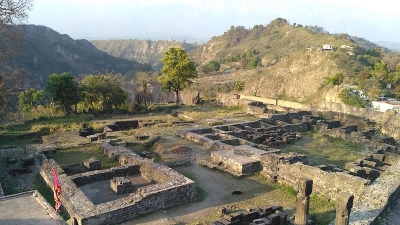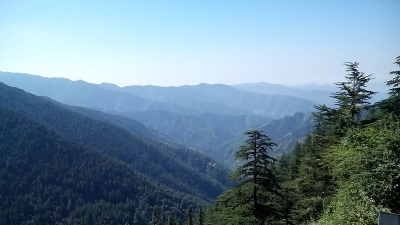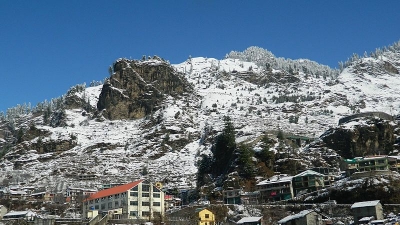Kangra Attractions - Tourist Places To Visit In Kangra
-
01Dharamkot
 + Read More
+ Read MoreDharamkot
Dharamkot or Dharmkot is a small village and a famous hill station in the Kangra district in the Indian state of Himachal Pradesh. One of the best places to visit in Kangra district, Dharmkot is not very far from the well-known McLeodGanj. The village is full of hilly terrain that attracts trekking enthusiasts, as all such trails offer breathtaking views of Kangra Valley and the Dhauladhar ranges.
In Himachal, some call Dharamkot Tel Aviv of hills. Dharamkot is the only village in Himachal that has a Jewish community center called the Chabad house. Places in the middle of the village, Chabad house looks like 770 Eastern Parkway. People over here can be found speaking Hebrew and Israeli dishes like falafel, shakshuka, and hummus with pita are easy to get at any local Restaurant. Because a good amount of Israeli people got settled down in Dharamkot, one can easily see the signboards written in Hebrew. Even keyboards in Internet cafes have Hebrew letters. Israeli people every year mark ceremonies here to celebrate Rosh-Hashana.
Famous Places In and Around Dharamkot
Dharamkot is famous for its peaceful environment. Tourists seeking a place to relax in the village can visit the Vipassana meditation center, Dhamma Shikara, and the Tushita Meditation Centre. These are the places that are known for being a center for the study and practice of Buddhism in the Tibetan Mahayana tradition.
The village has a single road that leads to it and the rest of the trails are either hilly or sloppy. That makes Dharamkot a place that attracts trekkers of all ages. Dharamkot serves as a base for multiple trekking trails such as Illaqua, Triund, Indrahar Pass, etc. various other viewpoints and waterfalls are also there to explore. Also, Dharamkot is very near to McLeodGanj, a suburb of Dharamshala. 9 km away from McLeodGanj, Triund is a famous trekking spot, situated at the foot of the Dhauladhar ranges, at a height of 2,827 m, and 4 km from Triund there is a place called The snow line. This is an easily accessible point in the Himalayan range that starts from Ilaqua. Dharamkot is an ideal destination to spend holidays with family and friends.
-
02Kangra Fort
+ Read MoreKangra Fort, also known as Nagar Kot, was constructed by the royal family of Kangra. It is situated at an altitude of 350 ft above sea level and spread across an area of 4 km. The site where the fort is situated is also known as the Purana Kangra, which is at a distance of 3 km away from the town of Kangra.
This fort not only finds mention in the great Indian epic of Mahabharata but also in the war records of Alexander the Great. Built at the convergence of the two rivers, namely, Banganga and Manjhi, the fort is bounded by thick walls and fortifications. To enter the fort, one has to pass through a small courtyard, which rests between the two gates.
The gate, having age old inscriptions of the Sikh period, is also known as ‘patak’ or Ranjit Singh Gate. Travelers can reach to the top of the fort via the Ahani and Amiri Darwaza, following a tapered passage from the entrance.
Nawab Alif Khan, the first governor of the Kangra territory built the gates of the fort. Tourists can also visit a polygonal watch tower, the Laxmi Narayan Temple and the Adinath temple situated in the fort.
-
03Bajreshwari Devi Temple
 + Read More
+ Read MoreBajreshwari Devi Temple, constructed in the 11th century, is devoted to the Hindu deity Vajreshwari. The temple exhibits the Shikhara style of architecture with its magnificent stone carvings. One of the two pillars placed at the entrance provides information about the period of construction of the temple.
At the exterior corner of the temple are placed the images of a four-armed Hindu Goddess Durga, seated on a lion, and Hindu deity Vishnu in his abode known as the Vaikuntha. In addition to this, one see carved pillars displaying the images of different Hindu gods and goddesses.
-
04Nagar Kot Fort
 + Read More
+ Read MoreNagarkot Fort is a popular tourist destination of Kangra, which was earlier known as Nagarkot. Overlooking the Kangra Valley, this fort is located on a rock which is the meeting point of Banganga and Manjhi streams.
This fort has giant wooden gates, wherein Ranjit Singh Darwaza is connected to Jehangiri Darwaza via ramparts. The latter opens up to a path which is covered with foliage and houses the mosque where Jehangir prayed. An arch called mehrab, which is in deteriorating condition due to the greenery, is still present near the mosque and half-ruined structures are present near it.
Andheri Darwaza is located beyond the mehrab. Among all the darwazas, Darshini Darwaza is the oldest structure still present here. This door opens up to an attractive courtyard that is tiled with stones and spreads around the boundaries. All of the rulers here built various religious structures in the Nagarkot Fort.
There are Jain shrines, beautiful temples and the Sheesh Mahal, a mirror-studded room that is located on the top of the fort. Visitors coming here can see the beautiful surroundings from the huge terrace and the watchtower.
-
05Masrur Temple
+ Read MoreMasrur Temple is a prominent tourist destination located in Masrur town at a distance of 15 km to the south of Kangra. 15 Shikhar temples that are situated inside the caves form a complex which is known as Masrur Temple. Amongst the 15 temples, Thakurdwara Temple has blackstone images of Hindu deities Rama, Lakshmana and Sita, while the sculpture of Lord Shiva stands in the middle. It has a square garbhagriha in the antarala while the other side of the temple has a rectangular mandapa with four huge columns and a mukha mandapa with four subsidiary shrines.
Representing Indo-Aryan style of architecture, this temple was constructed in the 10th century using a solid piece of rock. Due to its architectural style, it is said to be reminiscent of the Ajanta-Ellora temples. Dedicated to the Hindu God Shiva, the architectural design of the temple can be traced back to the 8th or 9th centuries.
-
06Dhauladhar Ranges
+ Read MoreThe Dhauladhar Range of mountains is the major tourist attraction of Kangra District. This range is the division of the southern outer Himalayas which rises to the north of Kangra and Mandi. Visitors can go for adventurous treks in this chain of mountains and bask in the spellbinding beauty of the region.
Hanuman-Ka-Tiba or White Mountain is the highest peak of the mountain range. Famous as the Outer Himalayas or Lesser Himalayas, this range begins near Dalhousie in the northwest and passes through the areas that fall near the banks of the Beas river in the Kullu District of Himachal Pradesh.
The altitude of the Dhauladhar Range varies between 3500 and 6000 m above sea level. Visitors can enjoy the mesmerising view of the mountains from Kangra Valley. The Dhauladhar Range has a rocky terrain with a lot of granites, slate stones (used to build roofs in the region), limestones and sandstones.
-
07Taragarh Palace
 + Read More
+ Read MoreSpread over a large area of 15 acres, Taragarh Palace is a major tourist destination of Kangra. Surrounded by lush green tea gardens, this place boasts of virgin beauty as it is one of the unexplored areas of Kangra.
Historically, it was known as ‘Alhila’, meaning the land of the semi-circular moon. Taragarh Palace was initially built as a summer resort and was acquired by the royal family of Jammu and Kashmir later.
Located at the foothills of the Dhauladhar Range, this palace is now a popular heritage hotel. Developed in the year 1930, the hotel features stunning interiors that exude class and sophistication. The rooms are decorated with old colonial furniture, wide facades and teak-panelled dining halls.
-
08Shiva Temple
 + Read More
+ Read MoreShiva Temple is a popular tourist destination located in Kathgarh in Kangra district. It is located at a distance of 54.7 km from Dharamshala and 181 km from Shimla. Visitors come to Kathgarh to worship the Hindu God Shiva in this famous temple. This shrine has a large Shivalingam, which is divided vertically into two parts. The bigger portion is worshipped as Lord Shiva, and the smaller part as worshipped Parvati Devi. The distance between the two Shivalingams keeps on increasing or decreasing, depending on the season.
According to legends, the Hindu gods Vishnu and Brahma fought to establish their superiority once. Then, Lord Shiva disrupted their fight in the form of a fire pillar and people believe that this fire pillar exists here in the form of the Shivalingam.
-
09Haripur-Guler
 + Read More
+ Read MoreExtremely popular among tourists, Haripur-Guler, which are known for the legacy of Guler Riyasat, are twin townships located in the Kangra District. The two towns are renowned among art enthusiasts for traditional Kangra and Pahari paintings. The distinct styles and techniques of the Guler style of painting flourished in the local families.
Haripur is situated at an altitude of 1811 ft above sea level and is separated from Guler by a small river. The stream passing through Haripur and Guler has led to the formation of a wetland, which has been declared as a Ramsar Wetland Site because of the large number of migratory birds that come here during the winters.
Several caves, a ruined fort and some temples built by Raja Hari Chand are present here that add to the charm of the place.
-
10Baglamukhi Temple
 + Read More
+ Read MoreThe Bagalamukhi Temple is a prominent tourist destination of Kangra District. Many devotees come here every day to worship the Hindu Goddess Bagalamukhi, who is regarded as one of the ten goddesses of wisdom in the Hindu mythology.
Situated on the roadhead of Dharamshala-Kangra-Chandigarh Highway, this temple is located at the entrance of Kotla Fort in Kangra. The name Bagalamukhi has come from the word Bagala and Mukha that mean bridle and face, respectively. Thus, etymologically, the name stands for 'one whose face has the power to rule'.
-
11Baba Baroh Temple
+ Read MoreBaba Baroh Temple is a popular tourist destination located approximately 52 km away from Dharamshala. Devoted to the Hindu God Krishna and his spouse Radha, this shrine is visited by many pilgrims everyday. Built by a local follower named B. R. Sharma, this temple is made of white marble and is famous for having the largest amount of white marble used in any of the temples in Himachal Pradesh. The idol of Goddess Durga placed inside the temple is made of metal. An ancient shrine devoted to Kali Nath Bhole Shankar is situated in proximity to Baba Baroh Temple.
-
12Kotla Fort
 + Read More
+ Read MoreKotla Fort is one of the renowned tourist destinations located on the highway between Shahpur and Nurpur, in the vicinity of Kangra. This fort provides a spectacular view of the surroundings to the visitors as it is nestled on an isolated peak surrounded by beautiful valleys.
Historically, this fort was constructed under the patronage of the kings of Guler. The journey to Kotla Fort offers visitors the opportunity to relax amidst a forest of lush green pine trees. Travellers can also visit Bagulamukhi Temple situated at the main door of this fort.
There is also a smaller shrine that is dedicated to the Hindu God Ganesh; this structure features a round roof, which resembles the Bengal roof architecture style. The temple is decorated with wall paintings on its outer walls, wherein one of the walls has three arches and niches.
-
13Behna Mahadev
 + Read More
+ Read MoreBehna Mahadev is a major tourist destination located in the Satluj Valley. Said to be one of the biggest temples in Satluj Valley, it is famous for having the largest gable-roofs. The unique stone-tiled roofs of this Hindu temple are held by angled struts. Its corridors and mandapa are open from all sides, and there are two balconies that intersect each other.
These balconies are beautifully decorated with finials as well as pointed roofs and have columns and beautiful carvings. The windows of this temple are embossed with animal friezes and floral designs.
-
14International Himalayan Festival
 + Read More
+ Read MoreThe International Himalayan Festival is a prominent festival held in McLeod Ganj, Kangra District every year in the month of December. It is sponsored by the Indo-Tibetan Friendship Society and supported by the Department of Tourism of Himachal Pradesh and the Central Administration of Tibet.
The festival is celebrated to signify that the Dalai Lama was conferred with The Nobel Peace Prize in the year 1985.This is a significant festival for Tibetans and is considered to be a symbol of global appreciation for the peace initiatives taken by the Dalai Lama.
The International Himalayan Festival is celebrated for three days as an endeavour to strengthen the harmony between the inhabitants of Himachal Pradesh and the Tibetans who live there. Visitors can enjoy various cultural shows and performances by artists of the Tibetan Institute of Performing Arts, locals and children.
-
15Sujanpur Fort
+ Read MoreSujanpur Fort, built in 1758 by the emperor of Kangra, King Abhaya Chand, is one of the beautiful buildings located in the town of Hamirpur in Sujanpur. The fort is also popular for its many paintings. During the early 19th century, the king of Kangra, Sansar Chand, a follower of the Pahari School of Miniature Paintings, lived here. When the emperor lost Kangra to the British, Sujanpur Fort became a shelter for him and his family.
There are 12 chambers and a hall in the building of this fort. The chambers here were made for the other kings who would come to meet with King Sansar Chand in Kangra. Situated on the banks of Beas river, the fort also has a Barahdari Hall where hearings were held. The large compound of this fort is now used for Holi celebrations, a popular Hindu festival of colours, which is celebrated for 3 to 4 days.
Some other popular spots here are the temples of Narvadeshwar, Gaurishankar and Murli Manohar.



 Click it and Unblock the Notifications
Click it and Unblock the Notifications










